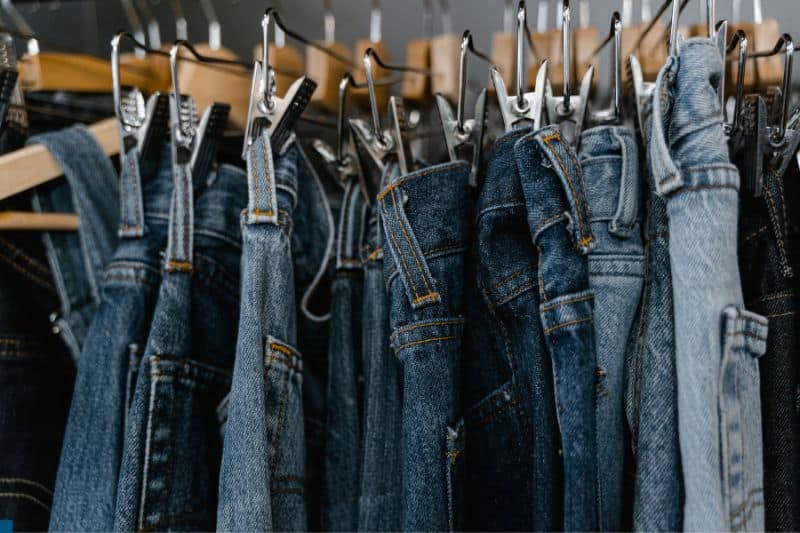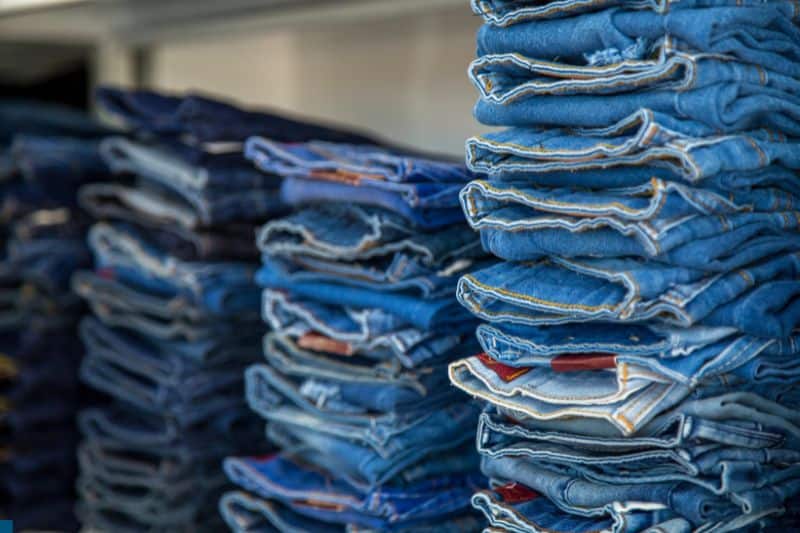When you’re out shopping for a new pair of jeans, you might not give much thought to how much they weigh. However, the weight of jeans can have an impact on your comfort, style choices, and even how much you end up paying for shipping if you’re shopping online.
Most jeans weigh somewhere between 12 and 32 ounces, with the average pair coming in around 16 to 20 ounces. The weight largely depends on the type of denim used and the various specific details of the jeans. For example, heavier denim with additional embellishments or thicker stitching will weigh more than lighter denim with minimal details.
Understanding the weight of jeans can help you make better decisions when purchasing, especially if you’re looking for a specific fit or feel. Heavier jeans are usually more durable, while lighter jeans can provide more breathability and flexibility. So, next time you shop for jeans, remember to consider their weight and how it factors into your overall satisfaction with the product.
Read: How Much Does a Fire Truck Weigh?
Classic denim jeans usually weigh around 12 to 16 ounces (340 to 453 grams). Skinny jeans often weigh slightly less, usually between 11 and 15 ounces (312 to 425 grams). Boyfriend jeans can weigh anywhere from 14 to 18 ounces (397 to 510 grams). Flared or bootcut jeans can range in weight from 13 to 17 ounces (369 to 482 grams).
Measuringly.com
Factors Affecting Jeans’ Weight
When it comes to jeans, you might be surprised to learn that their weight can vary quite a bit. This is due to several factors that influence the overall weight of the denim. In this section, we’ll discuss four main factors: Material, Size, Brand, and Style.
Material
One of the first factors that affect the weight of jeans is the material they’re made of. Jeans are typically made from cotton, but there are also jeans made from synthetic materials or blends. Different types of cotton, like organic, stretch, or heavyweight varieties, all come with different weights.
For example:
- Lightweight denim: usually around 9 to 11 ounces per yard
- Medium-weight denim: about 12 to 15 ounces per yard
- Heavyweight denim: typically 16 ounces or more per yard
Keep in mind that blends with materials like elastane, polyester, or nylon can also affect the overall weight of your jeans.
Size
As you’d expect, the size of jeans plays a role in their weight too. Larger sizes are naturally going to weigh more, as they require more material to be produced. The weight difference might not be enormous, but it is noticeable.
Brand
Different brands have different specifications and preferences when it comes to denim. Some brands focus on producing heavyweight jeans, while others lean towards lightweight denim, offering a softer and lighter feel. Naturally, the brand’s choice of material, construction methods, and design can all influence the weight of their jeans.
Style
Finally, the specific style of jeans can also affect their weight. Jeans with additional features like embroidery, prints, or appliques will weigh more because of the extra material used. Moreover, styles like skinny jeans, with tighter fits and less fabric, might be lighter than loose-fit or wide-leg jeans since they require less material.
In summary, the weight of a pair of jeans can vary greatly depending on factors like material, size, brand, and style. It’s essential to consider these when purchasing jeans, so that you will be comfortable and happy with your choice.

How Are Jeans Weighed?
When you want to determine the weight of your jeans, the process is quite simple. Start by gathering a few items: a scale, your pair of jeans, and possibly a container or hanger, if needed. Make sure your scale is accurate and calibrated, as this will ensure a precise measurement.
First, lay your jeans out flat on a clean surface. This helps to remove any wrinkles or folds that may affect the weight. Then, place the scale on a firm, level surface, making sure it is stable and correctly zeroed out. If you’re using a hanging scale, it’s essential to secure the jeans with a hanger or a container so they don’t slip off during weighing.
Place your jeans on the scale. For a flat scale, carefully lay the jeans on top, ensuring no parts hang over the edges. If you’re using a hanging scale, attach the hanger or container with jeans to the hook. Wait a few moments for the scale to register the weight, and then note down the resulting measurement. It’s always a good idea to weigh your jeans a couple of times to get consistent results.
Keep in mind that the weight of jeans can vary depending on factors such as:
- Size: Larger sizes will weigh more than smaller sizes due to the increased amount of fabric used.
- Style: Different cuts or styles of jeans may have varying amounts of fabric, resulting in different weights. For example, bootcut jeans may weigh a bit more than skinny jeans.
- Fabric Composition: The type of denim used can impact the weight of the jeans. Heavier, more robust denim will make for a heavier pair of jeans, while lighter denim will produce a lighter pair.
So, don’t be surprised if different jeans in your closet have varying weights – it’s entirely normal! With the right supplies and techniques, weighing your jeans is a simple process that anyone can master.
Read: How Much Does a Bar of Gold Weigh?
Weight Range of Different Jeans Styles
When it comes to jeans, you’ll find that their weight can vary significantly depending on the style, material, and brand. In general, a pair of jeans can weigh anywhere between 12 ounces and 32 ounces (340 grams to 907 grams). Let’s take a look at some common styles and their typical weight ranges.
Classic denim jeans usually weigh around 12 to 16 ounces (340 to 453 grams). These are the everyday jeans you’re likely used to wearing, made from medium-weight denim and featuring a casual, comfortable fit.
Skinny jeans often weigh slightly less, usually between 11 and 15 ounces (312 to 425 grams). Since they are designed to fit snugly on your legs, they tend to use lighter-weight materials to ensure comfort and flexibility.
Boyfriend jeans can weigh anywhere from 14 to 18 ounces (397 to 510 grams). This style is known for being roomy and relaxed, so they tend to use slightly heavier denim to achieve the desired fit and feel.
Flared or bootcut jeans can range in weight from 13 to 17 ounces (369 to 482 grams). These styles, which are characterized by a wider leg-opening, often utilize medium-weight denim to maintain the shape and style of the jeans.
Keep in mind that these weight ranges are estimates, and the actual weight of a pair of jeans can vary depending on the specific brand, materials used, and manufacturing techniques.
Additionally, factors such as embellishments, hardware, and added features can potentially impact the overall weight of a pair of jeans. So, when you’re shopping for your next pair, don’t forget to consider the weight and how it might affect your overall comfort and style.
Impact of Jeans Weight on Shipping Costs
When you’re shipping jeans, it’s essential to keep in mind that their weight can significantly affect shipping costs. Generally, lighter jeans will cost less to ship, while heavier ones will cost more. Various factors, such as the denim’s thickness, the number of embellishments, and the type of jeans (skinny, bootcut, etc.), can influence the weight.
Different carriers use various pricing structures, often based on the package’s weight and dimensions. Knowing the average weight of the jeans you’re shipping can help you compare prices and make an informed decision.
Typically, a pair of jeans weighs between 1 to 2 pounds. For instance, men’s jeans can average around 1.5 to 2 pounds, while women’s jeans may be slightly lighter at 1 to 1.5 pounds.
Here are a few friendly tips to optimize your shipping costs:
- Use lightweight packaging: Opt for lighter packaging materials, such as poly mailers or padded envelopes, instead of heavy cardboard boxes. This can help you save some money on shipping costs by reducing the overall package weight.
- Consolidate shipments: If you’re sending multiple pairs of jeans, consider combining them in one package to take advantage of potential shipping discounts or flat-rate shipping options.
- Compare carrier rates: Not all carriers charge the same rates for shipping based on weight. To find the best shipping option for your jeans, research various carriers’ rates, and compare them accordingly.
Remember, by understanding the impact of your jeans’ weight on shipping costs, you can make smarter choices when it comes to shipping rates and packaging. This will ultimately benefit both you and your customers by keeping costs low without sacrificing quality or efficiency.

Choosing the Right Pair Based on Weight
When selecting jeans, you might not immediately consider their weight. However, it can be an important aspect, especially for your comfort. Here are some factors to keep in mind when choosing the right pair based on weight.
Fabric: The type of fabric plays a significant role in determining the weight of jeans. Denim is usually made from cotton, but different blends can affect its thickness and weight.
- 100% cotton denim: This classic option is heavier and more durable but may take longer to break in.
- Stretch denim: A blend of cotton and elastane, this fabric is lighter and allows for more freedom of movement.
Weight categories: Jeans can be categorized into three weight classes, each with its unique features.
- Lightweight (12oz or below): Perfect for hot climates or those who prefer a softer, more breathable fabric.
- Mid-weight (12-16oz): This is the most common weight, offering a balance between durability and comfort.
- Heavyweight (16oz and above): Ideal for those who prioritize durability and long-lasting jeans but may require more break-in time.
Personal preferences: Your ideal jean weight might depend on the activities you do or the climates you live in. If you’re often on the move or in warmer environments, lightweight jeans could be a more comfortable choice. On the other hand, if you prefer a sturdier, more rugged look, a heavier pair might suit you best.
Seasons: Seasonal changes can influence the weight of the jeans you choose. Lightweight jeans could be your best bet during summer months, while heavier fabric might feel warmer and cozier during colder seasons.
In conclusion, paying attention to the weight of a pair of jeans can make a significant difference in your comfort and styling. Keep these factors in mind to pick the best jeans that fit both your lifestyle and personal preferences.
Read: What is the Average Weight of a 13-Year-Old in kg?
Jeans Weight by Brand
When you’re shopping for jeans, it’s essential to consider the weight of the denim. Different brands use varying fabric weights, giving their jeans unique characteristics. Here are some popular brands and their typical jeans weights.
Levi’s: Levi’s jeans come in a range of denim weights, but most of their classic styles, such as the 501 and the 511, are made from medium-weight denim around 12 to 14 ounces. A pair of Levi’s jeans typically weigh around 1.4 to 1.7 pounds (635 to 770 grams).
Wrangler: Wrangler is known for its durable and rugged denim, making its jeans heavier than some other brands. Their classic cowboy-cut jeans usually weigh around 1.5 to 2 pounds (680 to 907 grams), with denim fabric in the range of 14 to 16 ounces.
Gap: Gap offers a variety of denim styles, from lightweight to heavyweight. Their jeans often fall in the mid-range, weighing between 1.3 and 1.6 pounds (590 to 725 grams). You can expect their denim to be around 10 to 14 ounces.
American Eagle: American Eagle jeans tend to be lightweight and comfortable, featuring stretchy denim fabric. Their jeans typically weigh around 1 to 1.4 pounds (450 to 635 grams) and use fabric in the 9 to 12-ounce range.
In summary, the weight of a pair of jeans mostly depends on the brand and style. Some brands focus on heavier, durable denim, while others prioritize lighter fabrics for comfort and versatility. Keep these weights in mind when choosing your perfect pair of jeans.







